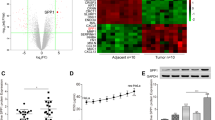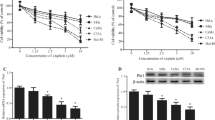Abstract
Cancerous inhibitor of protein phosphatase 2A (CIP2A) is a recently identified oncoprotein. Here, we investigated its role in the formation of multidrug resistance (MDR) of cervical adenocarcinoma in vitro and in vivo. MTT assay showed that knockdown of CIP2A expression increased the drug sensitivity of HeLa and Dox-resistant HeLa cells (HeLa-Dox) to doxorubicin, cisplatin, and paclitaxel significantly, while overexpression of CIP2A decreased the sensitivity of HeLa cells to chemo-drugs dramatically. When treated with different chemotherapeutics, CIP2A and P-glycoprotein (P-gp) protein levels were increased in HeLa cells simultaneously. In accordance with it, knockdown or overexpression of CIP2A expression inhibited or increased the P-gp expression in the transcription level separately. The effects of CIP2A on P-gp expression was achieved partly through its regulation on the transcription factor E2F1. Moreover, the interference of CIP2A could decrease the P-gp protein activity elucidated by Rhodamine 123 (Rh123) efflux assay in HeLa and HeLa/Dox cells. In the in vivo level, confocal microscopy data demonstrated the strong co-localization of CIP2A and P-gp protein in HeLa cells, and CIP2A protein expression was significantly associated with that of P-gp in cervical adenocarcinoma tissues. Thus, CIP2A is involved in regulating multidrug resistance of cervical adenocarcinoma upon chemotherapy by enhancing P-gp expression through E2F1. CIP2A may be an attractive target in anticancer strategies to improve the effect of chemotherapy in cervical adenocarcinoma.






Similar content being viewed by others
References
Yugawa T, Kiyono T. Molecular mechanisms of cervical carcinogenesis by high-risk human papillomaviruses: novel functions of E6 and E7 oncoproteins. Rev Med Virol. 2009;19(2):97–113.
Sherman ME, Wang SS, Carreon J, Devesa SS. Mortality trends for cervical squamous and adenocarcinoma in the United States. Relation to incidence and survival. Cancer. 2005;103(6):1258–64.
Fujiwara H et al. Gynecologic Cancer InterGroup (GCIG) consensus review for cervical adenocarcinoma. Int J Gynecol Cancer. 2014;24(9 Suppl 3):S96–101.
Pectasides D, Kamposioras K, Papaxoinis G, Pectasides E. Chemotherapy for recurrent cervical cancer. Cancer Treat Rev. 2008;34(7):603–13.
Amin ML. P-glycoprotein inhibition for optimal drug delivery. Drug Target Insights. 2013;19(7):27–34.
Juliano RL, Ling V. A surface glycoprotein modulating drug permeability in Chinese hamster ovary cell mutants. Biochim Biophys Acta. 1976;455:152–62.
Gottesman MM, Pastan I. Biochemistry of multidrug resistance mediated by the multidrug transporter. Annu Rev Biochem. 1993;62:385–427.
Zhang H, Zhang X, Wu X, Li W, Su P, Cheng H, et al. Interference of Frizzled 1 (FZD1) reverses multidrug resistance in breast cancer cells through the Wnt/β-catenin pathway. Cancer Lett. 2012;323(1):106–13.
Lopes-Rodrigues V, Seca H, Sousa D, Sousa E, Lima RT, Vasconcelos MH. The network of P-glycoprotein and microRNAs interactions. Int J Cancer. 2014;135(2):253–63.
Ambudkar SV, Dey S, Hrycyna CA, Ramachandra M, Pastan I, Gottesman MM. Biochemical, cellular, and pharmacological aspects of the multidrug transporter. Annu Rev Pharmacol Toxicol. 1999;39:361–98.
Junco JJ, Mancha A, Malik G, Wei SJ, Kim DJ, Liang H, et al. Resveratrol and P-glycoprotein inhibitors enhance the anti-skin cancer effects of ursolic acid. Mol Cancer Res. 2013;11(12):1521–9.
Schneider J, Efferth T, Mattern J, Rodriguez-Escudero FJ, Volm M. Immunohistochemical detection of the multi-drug-resistance marker P-glycoprotein in uterine cervical carcinomas and normal cervical tissue. Am J Obstet Gynecol. 1992;166(3):825–9.
Junttila MR, Puustinen P, Niemelä M, Ahola R, Arnold H, Böttzauw T, et al. CIP2A inhibits PP2A in human malignancies. Cell. 2007;130(1):51–62.
Li W, Ge Z, Liu C, Björkholm M, Jia J, Xu D. CIP2A is overexpressed in gastric cancer and its depletion leads to impaired clonogenicity, senescence, or differentiation of tumor cells. Clin Cancer Res. 2008;14(12):3722–8.
Niemelä M, Kauko O, Sihto H, Mpindi JP, Nicorici D, Pernilä P, et al. CIP2A signature reveals the MYC dependency of CIP2A-regulated phenotypes and its clinical association with breast cancer subtypes. Oncogene. 2012;31(39):4266–78.
Dong QZ, Wang Y, Dong XJ, Li ZX, Tang ZP, Cui QZ, et al. CIP2A is overexpressed in non-small cell lung cancer and correlates with poor prognosis. Ann Surg Oncol. 2011;18(3):857–65.
Vaarala MH, Väisänen MR, Ristimäki A. CIP2A expression is increased in prostate cancer. J Exp Clin Cancer Res. 2010;29:136.
Wang J, Li W, Li L, Yu X, Jia J, Chen C. CIP2A is over-expressed in acute myeloid leukaemia and associated with HL60 cells proliferation and differentiation. Int J Lab Hematol. 2011;33(3):290–8.
Liu J, Wang X, Zhou G, Wang H, Xiang L, Cheng Y, et al. Cancerous inhibitor of protein phosphatase 2A is overexpressed in cervical cancer and upregulated by human papillomavirus 16 E7 oncoprotein. Gynecol Oncol. 2011;122(2):430–6.
Côme C, Laine A, Chanrion M, Edgren H, Mattila E, Liu X, et al. CIP2A is associated with human breast cancer aggressivity. Clin Cancer Res. 2009;15(16):5092–100.
Yu HC, Chen HJ, Chang YL, Liu CY, Shiau CW, Cheng AL, et al. Inhibition of CIP2A determines erlotinib-induced apoptosis in hepatocellular carcinoma. Biochem Pharmacol. 2013;85(3):356–66.
Tseng LM, Liu CY, Chang KC, Chu PY, Shiau CW, Chen KF. CIP2A is a target of bortezomib in human triple negative breast cancer cells. Breast Cancer Res. 2012;14(2):R68.
Liu CY, Shiau CW, Kuo HY, Huang HP, Chen MH, Tzeng CH, et al. Cancerous inhibitor of protein phosphatase 2A determines bortezomib-induced apoptosis in leukemia cells. Haematologica. 2013;98(5):729–38.
Gao P, Zhou G, Guo L, Zhang QH, Zhen JH, Fang AJ, et al. Reversal of 355 drug resistance in breast carcinoma cells by anti-mdr1 ribozyme regulated by 356 the tumor-specific MUC-1 promoter. Cancer Lett. 2007;256(1):81–9.
Teodori E, Dei S, Martelli C, Scapecchi S, Gualtieri F. The functions and structure of ABC transporters: implications for the design of new inhibitors of Pgp and MRP1 to control multidrug resistance (MDR). Curr Drug Targets. 2006;7(7):893–909.
Ferrandina G, Mantegna G, Petrillo M, Fuoco G, Venditti L, Terzano S, et al. Quality of life and emotional distress in early stage and locally advanced cervical cancer patients: a prospective, longitudinal study. Gynecol Oncol. 2012;124(3):389–94.
Khanna A, Pimanda JE, Westermarck J. Cancerous inhibitor of protein phosphatase 2A, an emerging human oncoprotein and a potential cancer therapy target. Cancer Res. 2013;73(22):6548–53.
Laine A et al. Senescence sensitivity of breast cancer cells is defined by positive feedback loop between CIP2A and E2F1. Cancer Discov. 2013;3(2):182–97.
Yan LH et al. Overexpression of E2F1 in human gastric carcinoma is involved in anti-cancer drug resistance. BMC Cancer. 2014;14:904.
Zhang W et al. Cancerous inhibitor of protein phosphatase 2A contributes to human papillomavirus oncoprotein E7-induced cell proliferation via E2F1. Oncotarget. 2015;6(7):5253–62.
Abolhoda A, Wilson AE, Ross H, Danenberg PV, Burt M, Scotto KW. Rapid activation of MDR1 gene expression in human metastatic sarcoma after in vivo exposure to doxorubicin. Clin Cancer Res. 1999;5(11):3352–6.
Acknowledgments
This research was supported by the National Natural Science Foundation of China (grant no. 81000733), Shandong Province Natural Science Foundation (grant nos. ZR2011HQ036 and ZR2012HM031), and the National Natural Science Foundation of China (grant nos. 81101259 and 81472552).
Conflicts of interest
None
Author information
Authors and Affiliations
Corresponding author
Additional information
Juan Liu and Meng Wang contributed equally to this work.
Electronic supplementary material
Below is the link to the electronic supplementary material.
ESM 1
(DOC 228 kb)
Rights and permissions
About this article
Cite this article
Liu, J., Wang, M., Zhang, X. et al. CIP2A is associated with multidrug resistance in cervical adenocarcinoma by a P-glycoprotein pathway. Tumor Biol. 37, 2673–2682 (2016). https://doi.org/10.1007/s13277-015-4032-8
Received:
Accepted:
Published:
Issue Date:
DOI: https://doi.org/10.1007/s13277-015-4032-8




